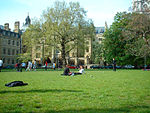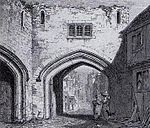Methodist Central Hall, Westminster

The Methodist Central Hall (also known as Central Hall Westminster) is a multi-purpose venue in the City of Westminster, London, serving primarily as a Methodist church and a conference centre. The building, which is a tourist attraction, also houses an art gallery, a restaurant, and an office building (formerly as the headquarters of the Methodist Church of Great Britain until 2000). It contains twenty-two conference, meeting and seminar rooms, the largest being the Great Hall, which seats 2,300.Methodist Central Hall Westminster occupies the corner of Tothill Street and Storeys Gate just off Victoria Street in London, near the junction with The Sanctuary next to the Queen Elizabeth II Conference Centre and facing Westminster Abbey.
Excerpt from the Wikipedia article Methodist Central Hall, Westminster (License: CC BY-SA 3.0, Authors, Images).Methodist Central Hall, Westminster
Storey's Gate, City of Westminster Millbank
Geographical coordinates (GPS) Address External links Nearby Places Show on map
Geographical coordinates (GPS)
| Latitude | Longitude |
|---|---|
| N 51.5 ° | E -0.13 ° |
Address
Methodist Central Hall
Storey's Gate
SW1P 3AT City of Westminster, Millbank
England, United Kingdom
Open on Google Maps









